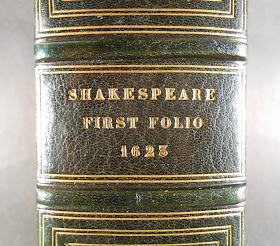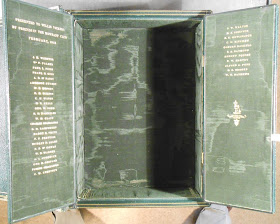 Here in Special Collections, we're fortunate enough to have one of the world's best collections having to do with polar and cold region exploration. The Stefansson Collection is named after its original owner, Vilhjalmur Stefansson, a lecturer at Dartmouth College who himself was an Arctic explorer in the early 20th century. Many people know about the numerous smaller collections that reside under the broad umbrella of the Stefansson Collection, such as the papers of Ada Blackjack, Admiral Robert Peary, or the diary of Thomas Orde-Lees, quartermaster and machinist for Ernest Shackleton's ill-fated Endurance expedition.
Here in Special Collections, we're fortunate enough to have one of the world's best collections having to do with polar and cold region exploration. The Stefansson Collection is named after its original owner, Vilhjalmur Stefansson, a lecturer at Dartmouth College who himself was an Arctic explorer in the early 20th century. Many people know about the numerous smaller collections that reside under the broad umbrella of the Stefansson Collection, such as the papers of Ada Blackjack, Admiral Robert Peary, or the diary of Thomas Orde-Lees, quartermaster and machinist for Ernest Shackleton's ill-fated Endurance expedition.However, not many people know about the sizable collection of Stefansson's correspondence that we have here at Rauner Library. Later in life, Stefansson became a public intellectual of sorts, at least when it came to anything having to do with Arctic exploration or indigenous communities within the Arctic Circle. He lectured widely across the country and, as a result of his popularity, was often sent letters by people seeking his approval or authentication for their own various books, projects, or speaking tours. Sometimes, he responded positively, supporting the petitioner's project. Often, however, he filed their requests, or the information they wanted him to validate, in a correspondence file titled "Fakes (Popular Errors & Misconceptions)."
Stefansson's correspondence is arranged by year and then alphabetically, so we have many many
"Fakes" files. One of my personal favorites is a letter sent to him in 1927 by a Mr. Earl Sims of the law firm Weltner & Sims based in Atlanta, Georgia. In his
 letter, Sims takes to task one Dillon Wallace, a fellow lawyer who wrote a best-selling book about a failed exploratory trip through Labrador. On the trip, which happened in 1903, Wallace's partner Leonidas Hubbard took ill and died of starvation, while Wallace was able to make it out alive. The book, published in 1905, took hold of the popular imagination. However, some people, Mr. Sims among them, took issue with the book. In his letter, Sims questions the validity of basic claims made by Wallace (for example, whether or not the two explorers had an axe along with them) as well as a very important detail related to the issue of starvation. Sims catalogs the copious number of fish that Wallace claims they caught and consumed during their period of so-called "famine." Sims concludes, rather tartly, that he is "prepared to believe that Hubbard may have died of over-eating, but not that he starved to death."
letter, Sims takes to task one Dillon Wallace, a fellow lawyer who wrote a best-selling book about a failed exploratory trip through Labrador. On the trip, which happened in 1903, Wallace's partner Leonidas Hubbard took ill and died of starvation, while Wallace was able to make it out alive. The book, published in 1905, took hold of the popular imagination. However, some people, Mr. Sims among them, took issue with the book. In his letter, Sims questions the validity of basic claims made by Wallace (for example, whether or not the two explorers had an axe along with them) as well as a very important detail related to the issue of starvation. Sims catalogs the copious number of fish that Wallace claims they caught and consumed during their period of so-called "famine." Sims concludes, rather tartly, that he is "prepared to believe that Hubbard may have died of over-eating, but not that he starved to death."To read more about various fakes, falsehoods, and popular misconceptions about the Arctic, come to Special Collections and ask to see a Fakes folder from the Correspondence of Vilhjalmur Stefansson (MSS-196).



